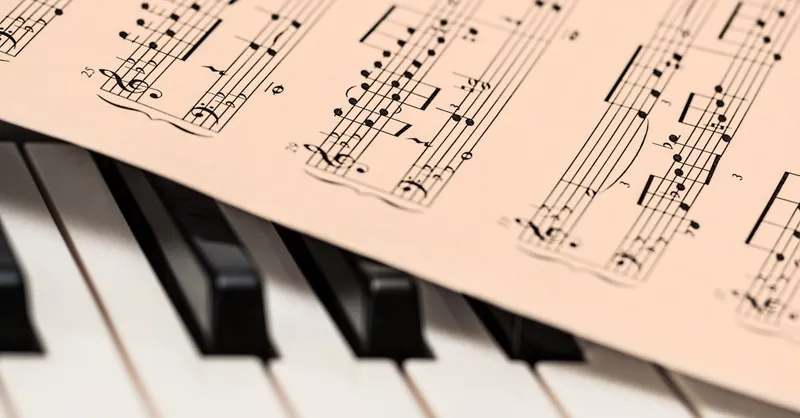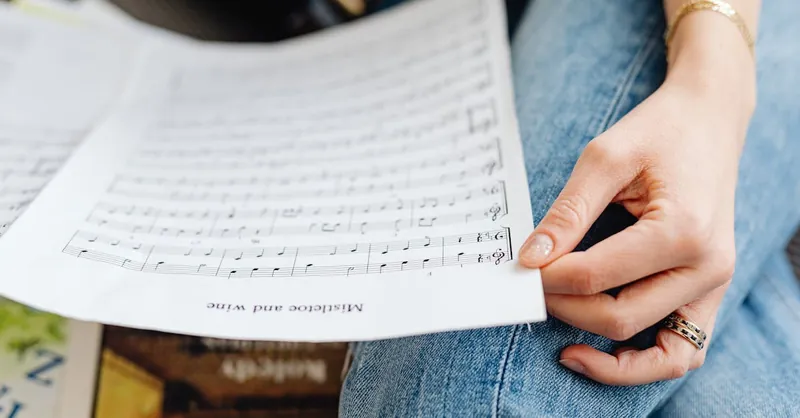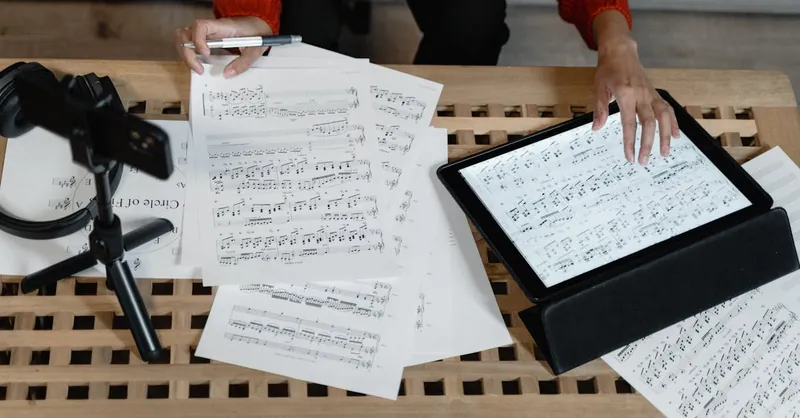How to Memorize Scales on Guitar and Piano Easily
Category: Music Theory
Mastering Scale Memorization on Guitar & Piano: A Beginner's Guide
If you've just started learning guitar or piano, you’ve likely encountered the challenge of memorizing scales. It’s a common hurdle—knowing the notes theoretically is one thing, but being able to recall and play them fluently from muscle memory is quite another. You might have tried repetitive drills or looked up complicated charts, but nothing seems to stick, making practice frustrating and slow. This post is crafted specifically for beginner musicians and music enthusiasts who want clear, straightforward strategies to memorize scales on both guitar and piano.
You’ve landed here because you want practical, digestible advice—not overwhelming jargon or abstract theory. We'll peel back the complexity with step-by-step methods that integrate music theory with hands-on exercises tailored for guitar and piano. Unlike many generic tutorials, this guide focuses on active memorization techniques and instrument-specific tips that enhance retention and playing ease. By the end, you'll have a solid roadmap to internalize scales, making improvisation, composition, and playing with confidence a reality.
Our approach bridges music theory fundamentals with real-world application, ensuring you don't just memorize scales— you understand them contextually on your instrument. So if you're ready to turn frustration into progress and unlock the full potential of your guitar or piano practice, let’s dive in.
- Mastering Scale Memorization on Guitar & Piano: A Beginner's Guide
- Understanding Why Memorizing Scales Matters
- The Basics of Scales: Understanding What Scales Are and Common Types
- Visualizing Scales on Guitar and Piano
- Breaking Down Scales into Manageable Patterns: Guitar Boxes and Piano Hand Shapes
- Effective Memorization Techniques for Scales on Guitar and Piano
- Hands-On Exercises for Guitar: Practicing Scales with Positions, Sequences, and Chords
- Hands-On Exercises for Piano: Step-by-Step Drills to Master Scale Fingerings and Improvisation
- Integrating Theory and Practice: Deepening Scale Memorization through Intervals and Chord-Scale Connections
- Using Backing Tracks and Apps: Making Scale Practice Engaging and Contextually Relevant
- Common Challenges and How to Overcome Them: Staying Motivated and Breaking Through Plateaus
Understanding Why Memorizing Scales Matters
Memorizing scales is a fundamental step that goes far beyond simply being able to play a sequence of notes on your guitar or piano. Developing a strong recall of scales directly impacts your technique, allowing for smoother finger transitions, increased speed, and greater precision. When scales become second nature, your hands learn the instrument’s layout in a more intuitive way, reducing hesitation and improving overall dexterity on both guitar fretboards and piano keys.
Moreover, scale memorization is the backbone of effective improvisation and creative expression. Knowing your scales thoroughly gives you the freedom to craft melodies on the fly, navigate chord changes gracefully, and experiment confidently with different musical styles. Rather than relying on guesswork, you’ll have a reliable framework for exploring new sounds, making your solos and compositions more coherent and engaging.
From a theoretical standpoint, memorizing scales deepens your understanding of music theory concepts such as intervals, key signatures, and chord construction. This enriched comprehension translates to better ear training and the ability to read and write music with confidence. Whether you’re a guitarist aiming to master pentatonic patterns or a pianist exploring major and minor scales, memorizing them lays the groundwork for all advanced musical skills. In short, committing scales to memory connects technique, creativity, and theory into a cohesive skill set that exponentially enhances your musicianship.

Image courtesy of Tima Miroshnichenko
The Basics of Scales: Understanding What Scales Are and Common Types
Before diving into memorization techniques, it's important to establish a solid foundation by understanding what scales actually are. In music theory, a scale is a sequence of notes arranged in ascending or descending order, which provides the tonal framework for melodies, chords, and harmonies. Scales serve as the building blocks for virtually all musical pieces and improvisations on guitar and piano.
Common Types of Scales and Their Structures
When learning scales on guitar or piano, beginners typically encounter three main categories: major scales, minor scales, and pentatonic scales. Each type has a distinct sound and structure defined by specific intervals between notes.
-
Major Scales
The major scale is arguably the most fundamental scale in Western music, known for its bright and happy tonal quality. It follows a consistent pattern of whole steps (two semitones) and half steps (one semitone):
Whole - Whole - Half - Whole - Whole - Whole - Half
For example, the C major scale consists of the notes: C - D - E - F - G - A - B - C. -
Minor Scales
Minor scales produce a darker, more melancholic sound and come in several variations, with the natural minor scale being the most basic. Its interval pattern is:
Whole - Half - Whole - Whole - Half - Whole - Whole
Using A minor as an example, the notes are: A - B - C - D - E - F - G - A. -
Pentatonic Scales
Pentatonic scales simplify scale memorization by using only five notes per octave instead of seven, making them especially popular for improvisation on guitar and piano. They have two common types: major pentatonic and minor pentatonic. The minor pentatonic scale, for instance, is widely used in blues and rock music and has the interval pattern:
Minor 3rd - Whole Step - Whole Step - Minor 3rd - Whole Step
In A minor pentatonic, the notes are: A - C - D - E - G - A.
Understanding these basic scale types and their interval patterns equips you with the fundamental tools to start recognizing scale shapes on the guitar fretboard and keyboard layouts on the piano. This knowledge will make memorization more intuitive, as you’ll not only memorize note sequences but also grasp the underlying logic of how scales are constructed and why they sound the way they do.

Image courtesy of Pixabay
Visualizing Scales on Guitar and Piano
One of the biggest challenges when memorizing scales is understanding how they physically manifest on different instruments, especially between guitar and piano. Each instrument has a unique layout that affects how scales are shaped, played, and ultimately reinforced in your memory. Developing a clear mental picture of these layouts is crucial for effective scale memorization.
How Scales Appear on the Guitar Fretboard
On guitar, scales are visualized as patterns or shapes spread across the six strings and multiple frets. Because the guitar’s tuning repeats every octave in different positions along the neck, scale notes form distinctive fretboard patterns that can be shifted up or down to play a scale in any key. Beginners benefit greatly from learning these movable scale shapes, since they connect music theory with physical, muscle-memory-friendly patterns.
- Scale patterns involve a combination of finger placement, string skipping, and horizontal movement along the frets.
- The same scale can have multiple shapes in different positions, which helps with fluency across the entire fretboard.
- Visualizing scale notes as a grid on the fretboard simplifies memorization by framing scales as geometric patterns rather than isolated notes.
How Scales Appear on the Piano Keyboard
In contrast, the piano’s layout is linear, with notes arranged sequentially from left (low pitches) to right (high pitches). Scales on the piano are a clear sequence of white and black keys, each corresponding to a particular pitch in the scale. This linear visual layout makes it easier for beginners to understand the stepwise nature of scales and the specific intervals between notes.
- Scale memorization on piano often begins with visualizing the pattern of whole and half steps across the keys.
- The alternating groups of two and three black keys serve as useful landmarks for locating scale root notes and key signatures.
- Unlike guitar, piano scales cannot be shifted with a simple pattern change — the keys themselves do not move — so memorization relies heavily on recognizing fixed key positions.
Why Familiarizing Yourself with Both Layouts Matters
To truly master scales, it’s essential to spend time visualizing and internalizing how each scale is structured on your instrument’s unique layout. This builds not only muscle memory but also a spatial and theoretical understanding of scales that enhances your sight-reading, improvisation, and composition skills.
Whether you’re sliding through fretboard patterns on guitar or flowing across piano keys, becoming comfortable with how scales appear and move on your instrument lays the foundation for deeper musical fluency. Regular practice that integrates these visualizations makes scale memorization intuitive rather than mechanical, connecting theory directly to the physical experience of playing guitar or piano.

Image courtesy of Tima Miroshnichenko
Breaking Down Scales into Manageable Patterns: Guitar Boxes and Piano Hand Shapes
A highly effective strategy to memorize scales on both guitar and piano is to break them down into smaller, more digestible patterns or motifs. Instead of trying to learn an entire scale all at once, dividing scales into familiar and repeatable segments makes the learning process more approachable and helps build muscle memory gradually.
Guitar: Using Scale Boxes and Positions
On guitar, scales are commonly divided into “boxes” or positions—small groups of notes confined within a few frets that form recognizable finger patterns. Each box represents a segment of the scale and can be shifted up or down the neck to play the scale in any key.
- Learn the five essential scale boxes: For example, the major scale is often taught through five interconnected box patterns covering the fretboard.
- Focus on memorizing one box at a time: Practice the notes and fingering within each box, then work on smoothly connecting boxes to navigate the entire scale.
- Visualize these boxes as geometric shapes: This spatial awareness simplifies recall, especially when improvising or soloing, since you’ll know where your hand should be positioned relative to the scale’s layout.
- Practice shifting boxes: Since each box represents a movable pattern, mastering this allows effortless transposition of scales to any key without relearning new notes.
Piano: Mastering Hand Shapes and Arpeggios
On piano, scales are often taught through consistent hand shapes and fingerings that align with the keyboard’s linear layout. Focusing on small groups of notes helps solidify muscle memory and facilitates smooth execution across octaves.
- Divide the scale into short, finger-friendly segments: For instance, practice playing scales by grouping notes into two- or three-note blocks, which are easier to memorize and transition between.
- Learn scale patterns through arpeggios and triads: These smaller triadic patterns within a scale create familiar motifs that reinforce the scale’s sound and structure.
- Use consistent fingering patterns: This develops automaticity in finger movement, allowing you to focus on musicality instead of technical difficulty.
- Practice playing scales in octaves or across multiple octaves: Repeating these hand shapes across the keyboard improves spatial awareness and reinforces scale layout.
Why Pattern-Based Learning Enhances Scale Memorization
Breaking scales into manageable patterns or motifs leverages both visual and kinesthetic memory, helping your brain and muscles internalize scales faster. For guitarists, the tactile feel of scale boxes anchors knowledge physically on the fretboard. For pianists, hand shapes and finger positions transform abstract note sequences into familiar motions. By practicing scales this way, beginners can:
- Reduce overwhelm and cognitive load by focusing on smaller, achievable goals.
- Build confidence incrementally as each pattern mastered is a tangible milestone.
- Connect theoretical knowledge with practical technique, reinforcing musical intuition.
- Improve improvisational agility by recognizing and manipulating familiar scale fragments in creative ways.
Adopting this pattern-focused approach creates a structured yet flexible framework to memorize any scale effectively, ensuring your practice sessions are productive, engaging, and aligned with the natural mechanics of your instrument.

Image courtesy of cottonbro studio
Effective Memorization Techniques for Scales on Guitar and Piano
Memorizing scales efficiently requires more than just repetition—it involves using proven cognitive techniques that help your brain and fingers internalize scale patterns deeply and naturally. By incorporating methods like spaced repetition, associative imagery, scale singing, and slow practice, you can reinforce your memory and improve recall on both guitar and piano.
1. Spaced Repetition: Practice with Purpose Over Time
Spaced repetition leverages the scientifically-backed idea that reviewing information at increasing intervals solidifies long-term memory. Instead of practicing a scale intensively all at once, break your practice sessions into shorter, regular intervals spread across days or weeks. For example:
- Start by practicing the scale daily for a week.
- Gradually extend the gap between practice sessions to every two days, then every four days.
- Review challenging scale patterns more frequently to prevent forgetting.
This approach prevents mental fatigue and keeps the scale fresh, promoting a strong, durable recall whether you're playing on guitar fretboard positions or piano keys.
2. Associative Imagery: Link Notes to Visual or Conceptual Cues
Creating mental images or stories connected to scale notes or finger patterns makes memorization more vivid and intuitive. For guitar players, imagine the physical shapes of scale boxes as visual "maps" on the fretboard. Pianists can visualize the sequence of white and black keys forming a recognizable pattern, like "stairs" or "waves". Some example strategies:
- Associate each note with a color or symbol.
- Picture a familiar melody or chord progression that uses the scale notes.
- Imagine your hand movements tracing geometric shapes or arrows on your instrument.
Using associative imagery taps into multiple memory pathways, combining visual, auditory, and kinesthetic learning styles to strengthen your grasp on scales.
3. Scale Singing: Internalize Sound and Pitch Connection
Singing scales aloud while playing is a powerful way to improve aural memory and pitch recognition simultaneously. This technique helps you connect the theoretical sequence of notes with their actual sound, increasing your musical intuition.
- Sing the scale degrees (e.g., do-re-mi) as you finger the notes.
- Hum the scale softly to yourself before playing.
- Practice call-and-response exercises by singing a note and playing it, or vice versa.
By engaging your voice, you anchor the scale in your auditory system, making it easier to recall and improvise by ear.
4. Slow Practice: Build Precision and Mindful Awareness
Playing scales slowly and deliberately is critical to encoding accurate motor memory. Slow practice breaks down the learning process, allowing you to focus on correct finger placement, timing, and tone on both guitar and piano.
- Start at a comfortable tempo where you can consistently play each note cleanly.
- Use a metronome to maintain steady rhythm and gradually increase speed.
- Pay close attention to hand positioning and smooth transitions between notes and scale boxes.
This mindful approach reduces mistakes and engrains precise patterns, making it easier to play scales fluently at faster tempos later on.
Integrating these effective memorization techniques into your daily routine transforms scale practice from a tedious task into a dynamic learning experience. By combining spaced repetition, visual associations, vocalization, and controlled slow practice, you ensure that scale memorization becomes not just faster, but also deeper and more enjoyable on both guitar and piano.

Image courtesy of Photo By: Kaboompics.com
Hands-On Exercises for Guitar: Practicing Scales with Positions, Sequences, and Chords
Building solid scale memorization on guitar is best achieved through practical, hands-on exercises that engage both your fingers and your musical understanding. Beyond simply running through single scale patterns, diversifying your practice with different scale positions, scale sequences, and integrating scale notes with chords accelerates learning and strengthens your fretboard fluency.
1. Playing Scales in Different Positions
Instead of confining yourself to one “box” or position, practice playing the same scale across multiple fretboard locations. This helps your brain and fingers link the scale’s interval structure with its various physical shapes on the guitar neck. Try these steps:
- Start by playing the major or minor scale in the open position.
- Shift up to 5th, 7th, and 12th fret positions, playing the identical scale pattern transposed.
- Connect these positions by practicing smooth transitions, hammer-ons, or slides between boxes.
This positional shifting not only increases your fretboard familiarity but also improves your finger dexterity and ear training by hearing the same scale in different tonal colors.
2. Using Scale Sequences for Pattern Recognition and Muscle Memory
Instead of playing scales purely linearly, use scale sequences—patterns that repeat notes in specific groups rather than simply ascending or descending. Common sequences include:
- Playing groups of three or four notes ascending and descending (e.g., 1-2-3, 2-3-4, 3-4-5).
- Practicing "four-note sequences" with a step-back pattern (e.g., 1-2-3-4, 2-3-4-1, 3-4-1-2).
These exercises break monotony and force your fingers to negotiate more complex movements, encouraging faster internalization of scale shapes and strengthening muscle memory. Scale sequences also improve your improvisational vocabulary by familiarizing you with melodic fragments within the scale.
3. Mixing Scale Patterns with Chord Shapes
Integrating scale practice with chord fingerings connects theory to real-world playing—crucial for songwriting and improvisation. You can:
- Identify the chord tones within your scale pattern and emphasize these notes when playing.
- Alternate between playing chord shapes and scale runs in the same key or position.
- Create simple riffs by combining chord stabs and scale fragments, reinforcing which scale notes complement which chords.
For example, practice the A major scale and frequently land on the A major chord tones (A, C#, E) when soloing. This exercise develops a deeper understanding of how scales and harmony relate, guides your ear towards consonant tones, and enhances your ability to create musically pleasing solos on guitar.
By regularly incorporating these hands-on exercises into your guitar practice, you not only memorize scales more effectively but also develop practical skills that translate directly into better improvisation, rhythm playing, and overall fretboard mastery. Consistency and variety in scale practice transform theoretical knowledge into fluent, confident musicianship.

Image courtesy of Photo By: Kaboompics.com
Hands-On Exercises for Piano: Step-by-Step Drills to Master Scale Fingerings and Improvisation
Memorizing scales on piano benefits immensely from structured, hands-on exercises that emphasize proper fingerings, hands-separate practice, and creative application. Unlike guitar, where scale shapes shift positionally, piano scale practice centers around refining consistent finger patterns and developing fluid coordination between both hands. Follow these practical steps to build robust scale memory and enhance your piano technique:
1. Mastering Scale Fingerings with Hands Separately
Start by learning the standard fingerings for your target scale—whether major, minor, or pentatonic. Good fingering habits create reliable muscle memory and prevent awkward hand movements. For example, the C major scale fingering for the right hand is typically 1-2-3-1-2-3-4-5 (thumb through pinky), while the left hand often uses 5-4-3-2-1-3-2-1.
- Practice playing the scale slowly with each hand separately, focusing on smooth transitions between fingers and maintaining a relaxed hand position.
- Use a metronome to keep steady timing, gradually increasing speed only when accuracy is consistent.
- Pay special attention to the finger crossings (such as the thumb tucking under or the third finger crossing over), as mastering these is key to fluid scale playing.
- Repeat this hands-separate drill daily to solidify finger independence and confidence before combining hands.
2. Coordinating Both Hands Together
Once you can play scales fluently with each hand, the next step is to coordinate both hands simultaneously, which develops essential bi-manual control and hand synchronization.
- Begin by playing scales hands together at a slow tempo, matching the rhythm and ensuring notes align perfectly in time.
- Break the scale into smaller segments (2-4 notes) and practice those sections hands together before attempting the full scale.
- Keep your hands relaxed and observe any tension or timing mismatches, adjusting fingerings if necessary.
- Use a metronome to build steady rhythm and gradually increase tempo as your coordination improves.
3. Incorporating Scale-Based Improvisation and Musical Exploration
To truly internalize scales on piano, go beyond rote playing by incorporating improvisation and creative exercises based on scale notes. This bridges memorization with real musical application, enhancing both your ear and your spontaneous playing skills.
- Improvise simple melodies using only the notes of the scale you are practicing—start slowly and focus on creating smooth, pleasing phrases.
- Experiment with call-and-response patterns: play a short scale fragment, then create a complementary phrase responding to it.
- Combine scale practice with basic chord progressions built from the same scale to explore harmony and develop your sense of musical structure.
- Record your improvisations to track progress and identify areas for improvement.
By systematically practicing scale fingerings hands separately, then hands together, and finally integrating scale-based improvisation, pianists develop strong, flexible scale fluency. This approach not only improves technical skills like finger independence and precision, but also nurtures musical creativity, helping beginners transform memorized scales into expressive tools for playing and composing.

Image courtesy of Rene Terp
Integrating Theory and Practice: Deepening Scale Memorization through Intervals and Chord-Scale Connections
A crucial step in mastering scale memorization on guitar and piano is integrating music theory with hands-on practice, specifically by understanding the role of interval relationships and chord-scale connections. Rather than treating scales as arbitrary note sequences, recognizing how intervals form the framework of scales sharpens your mental map and accelerates recall. Intervals—the distance between two notes—define the unique character of each scale and help you predict which notes come next, making memorization far more intuitive.
For example, knowing that a major scale consists of a specific sequence of whole and half steps (intervals) enables you to reconstruct the scale on any starting note without rote memorization of individual notes. This interval perspective encourages active engagement with scales, allowing you to hear and feel the relationships between notes as you play.
Equally important is understanding chord-scale connections, which link scales directly to harmony and practical musical use. Each chord within a key corresponds to a subset of notes from the scale, called chord tones, which represent stable anchor points. By identifying these chord tones within scale patterns, you reinforce your memory with harmonic context and improve your ability to create musical phrases that "fit" the underlying chords.
How This Integration Enhances Guitar and Piano Practice
-
On guitar, visualizing intervals between notes within scale boxes helps navigate the fretboard more confidently. Recognizing where key chord tones—and their intervals—fall within scale shapes guides your improvisation toward more expressive and harmonically relevant note choices.
-
On piano, understanding intervals helps you anticipate fingerings and key relationships, while linking scale notes to chord tones deepens your grasp of harmonic progressions. This connection encourages you to highlight chord tones during scale runs and improvisations, resulting in more musically grounded and memorable phrases.
By merging theory with practice—focusing on intervals and chord-scale relationships—you transform scale memorization from an isolated mechanical task into an integrated skill. This method not only improves memory retention but also empowers you to apply scales creatively and confidently in real musical situations on both guitar and piano.

Image courtesy of Tima Miroshnichenko
Using Backing Tracks and Apps: Making Scale Practice Engaging and Contextually Relevant
One of the most effective ways to memorize scales on guitar and piano is by practicing with backing tracks and mobile apps, which transform repetitive scale drills into fun, musical experiences. Backing tracks provide a harmonic and rhythmic context for scales, helping you internalize their sound within real musical settings rather than isolated note sequences. When you practice scale patterns along with a backing track—for blues, jazz, pop, or rock grooves—you develop a stronger sense of timing, phrasing, and key center, all of which accelerate memorization and improve your ability to apply scales creatively.
Benefits of Using Backing Tracks and Apps in Scale Practice
- Contextual Learning: Playing over chord progressions allows you to hear how scale notes interact with harmonies, making theoretical knowledge practical and meaningful.
- Improved Timing and Rhythm: Backing tracks keep you locked in time, which is essential for developing musical phrasing when using scales in improvisation.
- Enhanced Motivation and Focus: Interactive apps and engaging tracks break the monotony of scale drills, helping sustain a consistent practice routine.
- Instant Feedback and Tracking: Many apps provide immediate feedback and customizable exercises that adapt to your skill level, promoting efficient, goal-oriented practice.
Recommended Resources for Guitar and Piano Scale Practice
- YouTube Backing Track Channels: Channels like Quist or Elevated Jam Tracks offer extensive free backing tracks in various genres and keys—perfect for scale improvisation practice.
- Mobile Apps for Scale Learning:
- Yousician and Fretboard Hero (for guitar) feature interactive lessons and real-time feedback on your playing.
- Simply Piano and Flowkey (for piano) incorporate scale exercises within songs and improvisation modules.
- iReal Pro is versatile for both guitar and piano users, allowing you to customize chord progressions and practice scales over realistic band accompaniments.
- Backing Track Websites: Platforms like JamTracks and BackingTracks.io let you filter by style, key, and tempo, tailoring your practice to specific scale sets.
How to Integrate Backing Tracks and Apps into Your Practice Routine
- Begin by selecting a backing track in the key of the scale you want to memorize.
- Start playing the scale slowly over the track, focusing on timing and note accuracy.
- Gradually incorporate scale fragments, sequences, and improvisational ideas as discussed earlier.
- Use apps for guided lessons and challenges to reinforce fingerings and theory.
- Regularly alternate between isolated scale drills and contextual practice with backing tracks to balance technical precision with musicality.
By leveraging backing tracks and apps, you make scale memorization dynamic, interactive, and musically relevant, which not only enhances recall but also equips you with practical skills to apply scales fluidly in performances and jam sessions on both guitar and piano.

Image courtesy of Tima Miroshnichenko
Common Challenges and How to Overcome Them: Staying Motivated and Breaking Through Plateaus
When learning to memorize scales on guitar and piano, beginners often encounter common obstacles that can hinder progress and dampen motivation. Recognizing these challenges early and implementing effective strategies to overcome them is key to maintaining consistent growth and enthusiasm throughout your musical journey.
Typical Memorization Challenges Beginners Face
-
Overwhelm from Complexity
Scales can appear intimidating due to the sheer number of notes, fingerings, and positions involved. Trying to learn too much at once often leads to confusion and frustration. -
Plateaus in Progress
After initial improvements, many learners hit a plateau where scale memorization feels stagnant. This can cause boredom or self-doubt, making it harder to stay committed. -
Lack of Motivation from Repetitive Practice
Repeating scales mechanically without clear goals or variation often makes practice sessions dull, reducing the likelihood of regular engagement. -
Difficulty Connecting Theory to Practical Playing
Memorizing notes without understanding how scales function musically can make the learning feel abstract and disconnected from real music-making.
Actionable Tips to Overcome These Challenges
-
Break Down Practice Into Small, Focused Goals: Instead of attempting to master an entire scale or multiple positions in one go, divide your practice into manageable chunks—such as learning one scale box on guitar or one octave at a time on piano. This focused approach reduces cognitive overload and builds confidence incrementally.
-
Incorporate Variety and Musical Context: Use backing tracks, scale sequences, or improvisation exercises to make practice engaging and relevant. Applying scales in real musical situations reinforces memorization and keeps motivation high.
-
Embrace Plateaus as Part of the Learning Process: Recognize that plateaus are natural and temporary. Use them as opportunities to refine technique, revisit theory concepts, or try new practice methods like slowed-down playing or singing scales aloud.
-
Track Your Progress and Celebrate Small Wins: Keep a practice journal or record yourself regularly to observe improvements over time. Celebrating milestones, no matter how small, boosts morale and helps maintain momentum.
-
Connect Theory with Physical and Aural Practice: Continually link scale memorization with theoretical understanding—such as intervals and chord scales—while simultaneously training your ear through singing or call-and-response exercises. This multisensory approach deepens retention and makes scales more meaningful.
By proactively addressing these challenges with focused strategies, beginners can transform scale memorization from a frustrating chore into a fulfilling and sustainable practice habit on both guitar and piano. This mindset not only accelerates learning but also lays a strong foundation for confident, creative musicianship.

Image courtesy of Artem Podrez
